We continue our celebration of Disney’s game-changing classic Snow White and the Seven Dwarfs with more albums based on the score.

1963: Snow White and the Seven Dwarfs – All the Songs from the Walt Disney Movie and An Adaptation of the Story by the Brothers Grimm (Golden/Wonderland)
Narrated and adapted by Golden Records regular John Allen, this album must have been the result of various business agreements. It contains the film songs, owned to this day by the Bourne company. However, it is not the Disney story, so the songs are rearranged slightly so the story could be altered. Disney owns their version of the story and characters. Golden Records had gone from being a licensee of the Walt Disney Music Company in the fifties to a retail competitor of Disneyland Records in the sixties
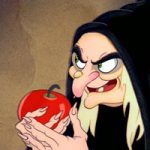 It’s interesting to hear the result of using the Grimm story elements and keeping the Disney story to a minimum to support the songs. The dwarfs are not given names, though Allen mentions that one sneezes. Instead of Snow White eating the apple during the Queen/witch’s visit, Snow White puts the fruit on a shelf, letting several hours pass before eating it. At the end of this adaptation, the defeated Queen makes an angry face and it stays that way — some of our moms warned us about that!
It’s interesting to hear the result of using the Grimm story elements and keeping the Disney story to a minimum to support the songs. The dwarfs are not given names, though Allen mentions that one sneezes. Instead of Snow White eating the apple during the Queen/witch’s visit, Snow White puts the fruit on a shelf, letting several hours pass before eating it. At the end of this adaptation, the defeated Queen makes an angry face and it stays that way — some of our moms warned us about that!
The songs are under the mellow baton of Jim Timmens, with a few tunes bearing the music beds from earlier Mitch Miller/Jimmy Carroll versions. Singing for Snow White is Broadway song demo and studio singer Rose Marie Jun, who gave the world the gift of “Push Button Blues” for Golden’s Jetsons LP. The Prince is sung by a renowned singer and vocal arranger who called himself “The Other Ray Charles,” because he was not the legendary jazz/blues performer. This Ray Charles worked on countless TV, film, and recordings, but is best known as the singer (with Julia Rinker) of the theme song to Three’s Company.
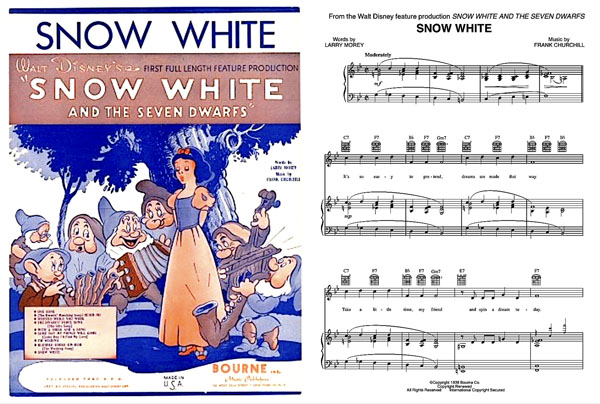
It may come as a surprise to some that there was a song actually called “Snow White.” It was written during the course of the film’s production by Ned Washington and Leigh Harline, just along with the rest of the score. “Snow White” may have been what Hollywood called a ‘promotional’ song,”
Russell Schroeder, author of Disney’s Lost Chords books, told me: “There were a lot of these songs that were made just for publicity purposes, just to help promote movies. We can’t be sure if the ‘Snow White’ song was considered for the film itself – it’s not really that great of a song.” Conceivably it could have been pitched to Walt Disney for the prince to sing and was overruled by “One Song.”
Side one
Side two
1966: The Songs from Walt Disney’s Snow White and the Seven Dwarfs
(Happy Time/Mr. Pickwick)
New York-based Pickwick International was a strong contender in the children’s and budget record business. The Cricket label became Happy Time in the early sixties, combining early material with new records. This version was made specifically for Happy Time Records, which were easy to find in grocery, department, and record stores – sometimes on special “budget racks” as they sold for ninety-nine cents or less.
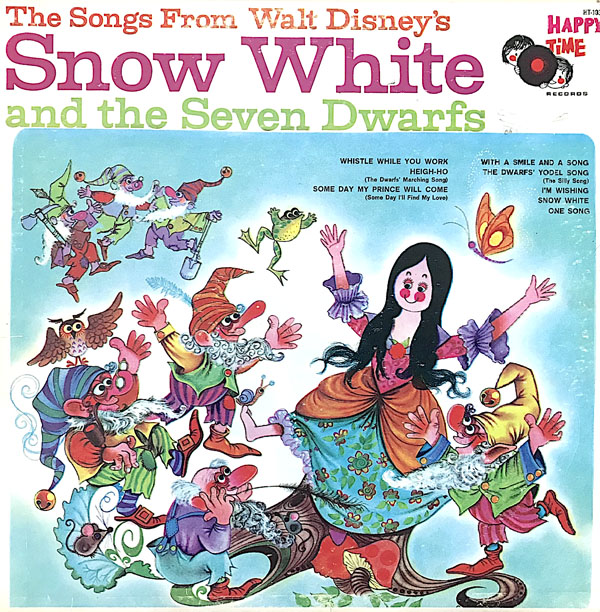
Almost every late sixties/early seventies Happy Time record featured musical direction by “Bugs” Bower, delivering a simple and easygoing sound befitting the budget. Bower added some original “hooks” to the arrangements to make the songs even more catchy than they already are.
Frequent Pickwick lead singer/actors Connie Zimet, Ron Marshall, and Lionel Wilson provide the vocals for this Snow White album.
Marshall was a leading vocal director as well as a voice actor (The Easter Bunny is Comin’ to Town, The Year Without a Santa Claus), Zimet was ubiquitous on commercials and recordings for Pickwick and Golden. She was also the voice of Burdine’s department stores for many years.
Lionel Wilson has legendary status as ALL the voices on Tom Terrific and the 1969 animated Winky Dink and You! as well as Eustace on Courage the Cowardly Dog. We paid tribute to Wilson in this Animation Spin.
Like the Golden LP above, this album is notable for the presence of the lesser-known “Snow White” song. In 1974, all the songs were reissued in full stereo on the Mr. Pickwick label, fronted by a 1953 version of the generic Snow White story told by Ralph Lowe.
BONUS SNOW WHITE RECORDS!
1961: Snow White and The Three Stooges – The Original Sound Track Recording (Columbia)
The following two albums bring the Spin total to seven. They do not present the story or songs from Walt Disney’s Snow White and the Seven Dwarfs, but there are some comparison points.
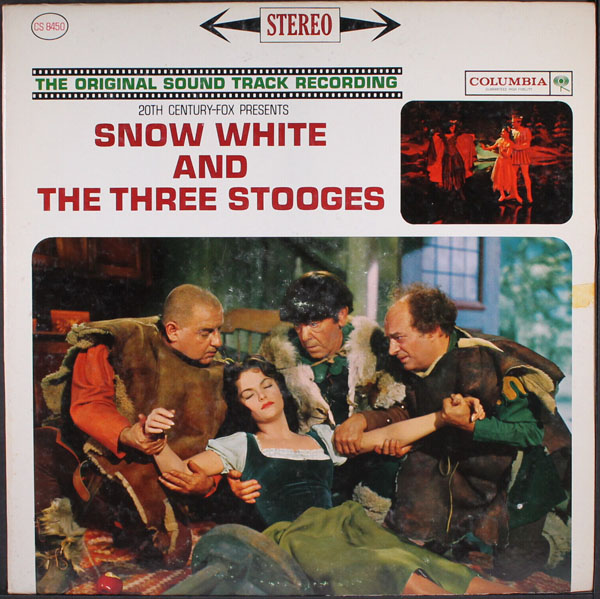
As a 20th Century Fox feature, Snow White and the Three Stooges currently falls under The Walt Disney Company, a fact unthinkable in 1961 when this film was released. This was the second feature-length Stooges movie and the only one in Technicolor.
It was one of the many results occurring when The Three Stooges found themselves in a resurgence. Television reruns of their early short films brought them to an eager, freshly minted young audience. They finally were awarded the fame, adoration, and commercial potential so found elusive in the low-paying Columbia days (note: never underestimate or devalue your back catalog, it’s the gift that keeps on giving).
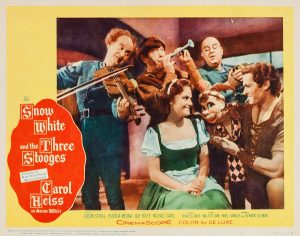 Moe Howard, Larry Fine, and “Curly Joe” DeRita (the last of a succession of third Stooges) moved into the 1960s festooned with new merchandise, a cartoon series, and several features, starting with 1959’s successful Have Rocket Will Travel. Combining the now more kid-friendly, less violent Stooges with a Disney-like fairytale must have seemed to make sense. Abbott and Costello’s Jack and the Beanstalk (1952) had been fairly successful, using a slightly larger budget and original songs. The Stooge feature was planned as a low-budget project as well.
Moe Howard, Larry Fine, and “Curly Joe” DeRita (the last of a succession of third Stooges) moved into the 1960s festooned with new merchandise, a cartoon series, and several features, starting with 1959’s successful Have Rocket Will Travel. Combining the now more kid-friendly, less violent Stooges with a Disney-like fairytale must have seemed to make sense. Abbott and Costello’s Jack and the Beanstalk (1952) had been fairly successful, using a slightly larger budget and original songs. The Stooge feature was planned as a low-budget project as well.
Instead, it became the most expensive Stooge film ever made. In today’s dollars, it would cost over 31 million dollars, astronomical for a Three Stooges movie. Apparently, even Frank Tashlin was brought in to handle some direction and work on the screenplay, co-authored by Wizard of Oz scenarist Noel Langley. One script problem became balancing the Stooges with the fairy tale elements, a similar dilemma faced UPA with their 1959 Mister Magoo feature, 1001 Arabian Nights. The film did not meet the expectations of fans of Stooge comedies or family musicals.
However, the soundtrack has a lot going for it — the voices of Mel Blanc (as the puppet Quinto); Bill Lee (singing voice of Christopher Plummer in The Sound of Music, Yogi in Hey There It’s Yogi Bear, and a member of The Mellomen); Norma Zimmer (the Lawrence Welk “Champagne Lady” who sang in Disney’s Cinderella and Alice in Wonderland); and musical direction by the Lyn Murray (whose Decca Snow White album was featured in last week’s Spin. McHale’s Navy and Twilight Zone fans will recognize Edson Stroll as the Prince.
The full-length feature (in CinemaScope) is here. The soundtrack album is embed below:
1965: Snow White and The Seven Dwarfs – Original Sound Track Recording of the Childhood Productions Classic Motion Picture (Golden)
Childhood Productions was one of a handful of small, independent film companies that thrived during the era of children’s matinees. The admission was about 25 or 50 cents; sometimes there were prizes and even birthday parties.
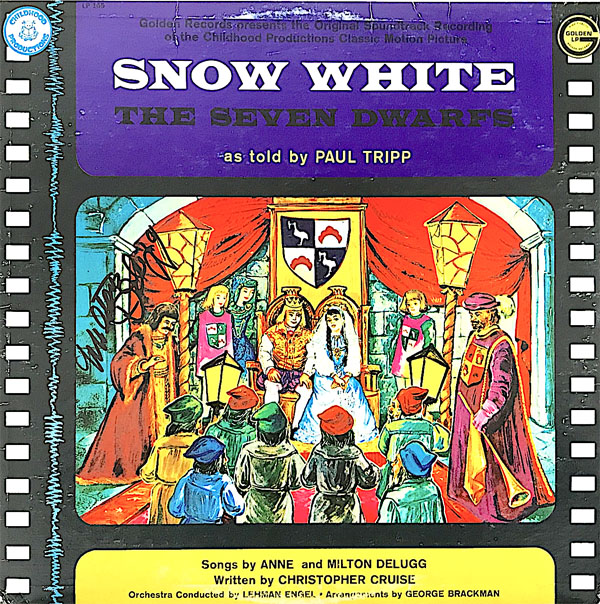
Actor/songwriter Paul Tripp, who with composer George Kleinsinger gave the world “Tubby the Tuba” (which we explored in detail in this Animation Spin), was a partner in Childhood Productions and narrated most of the features. Most were retellings of fairy tales on a modest budget, using lots of outdoor photography and the castles they could find locally, like the Neuschwanstein castle also used in The Wonderful World of the Brothers Grimm and Chitty Chitty Bang Bang.
The German version of Snow White and the Seven Dwarfs was released in 1955; the English language edition came to the U.S. ten years later. The musical score was completely changed but created to match the rhythm and staging of the German songs. Most of the songs were written by TV legend Milton DeLugg with his wife Anne.
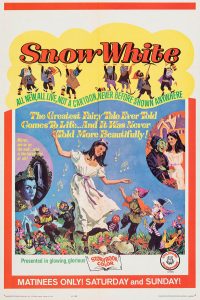 Milton DeLugg is probably best remembered from The Gong Show, but he also arranged and conducted the Macy’s Thanksgiving Day Parade TV music for decades and was the musical director of The Tonight Show before it moved from New York to Los Angeles. He also scored the excellent Japanese feature, Gulliver’s Travels Beyond the Moon, which was covered in this Animation Spin.
Milton DeLugg is probably best remembered from The Gong Show, but he also arranged and conducted the Macy’s Thanksgiving Day Parade TV music for decades and was the musical director of The Tonight Show before it moved from New York to Los Angeles. He also scored the excellent Japanese feature, Gulliver’s Travels Beyond the Moon, which was covered in this Animation Spin.
The musical director of Childhood Productions’ Snow White is Lehman Engel, also a legend in the music and recording industry. New York actors provided the voices, but none were credited. They sound as if they are the same people who appeared on the MGM children’s records of the same era. Several were veterans of the classic radio show, Let’s Pretend, like Sybil Trent, Ian Martin, Anthony Holland, and Evelyn Juster.
Golden Records released the story soundtracks for Snow White, Hansel and Gretel, Sleeping Beauty, and The Bremen Town Musicians. (It’s nice to see “Golden Records” listed in the film credits.) RCA Camden released The Big Bad Wolf, Cinderella, Snow White and Rose Red, and Tripp’s holiday epic, The Christmas That Almost Wasn’t, most in stereo as well as mono.
The film is more traditional as far as the Grimm source material is concerned, depicting some of the more harsh aspects of the Grimm tale that the Disney version omitted, like the various way the witch attempted to kill Snow White before she succeeded (sort of) with the apple.
All the Childhood Productions films capture an extremely quaint, old-World kind of children’s film, the sort of thing Kukla, Fran & Ollie presented weekly on The CBS Children’s Film Festival.
Here is a link to the feature film – And here is the record album:


 GREG EHRBAR is a freelance writer/producer for television, advertising, books, theme parks and stage. Greg has worked on content for such studios as Disney, Warner and Universal, with some of Hollywood’s biggest stars. His numerous books include Mouse Tracks: The Story of Walt Disney Records (with Tim Hollis). Visit
GREG EHRBAR is a freelance writer/producer for television, advertising, books, theme parks and stage. Greg has worked on content for such studios as Disney, Warner and Universal, with some of Hollywood’s biggest stars. His numerous books include Mouse Tracks: The Story of Walt Disney Records (with Tim Hollis). Visit 





















































I have seen “Snow White And The Three Stooges” many times, and especially love the songs, particularly “Place Called Happiness”.
According to Filmic Light :https://filmic-light.blogspot.com/search?q=snow+white+and+the+three+stooges:
“SW3S was initially written as a straight-forward telling of the fairy tale.”
i.e. without the Stooges
“But when the Three Stooges suddenly became popular again late in their careers, it was decided that this production would be the perfect vehicle for a brand new generation to experience their slapstick and would mark the first time they would appear in glorious color. ”
It also makes logical sense, because the alternative would have been to find 7 little men –
the pool of actors available to fit the acting and skills required would be very limited.
The film generally gets a bad rap from three stooges fans because they are not the star –
Carol Heiss is the star of this film.
It is Not called “The Three Stooges Meet Snow White” (unlike the movies they then did at Columbia with their names at the beginning of the title. They are co-stars only.
The dwarf’s cottage in this film also closely resembles the Disney dwarf’s cottage.
Art Director Jack Martin Smith, who went to Disney in 1977 to do Pete’s Dragon, clearly had a Disney inspiration.
Often we can appreciate things more by celebrating what they are rather than what they are not. Your appraisal of Snow White and the Three Stooges is really fine (Larry Fine?)
Legendary Hollywood art director Jack Martin Smith (father of Charles Martin Smith) worked for Walt Disney Imagineering. His art is among the paintings in the lobby of The American Adventure in Epcot.
Count me in as one who recalls SNOW WHITE AND THE THREE STOOGES with fondness. This played kiddie matinees for years after its initial release; I must have seen this three times. The songs are very nice, and it’s a good workmanlike adaptation of the story; the Stooges are well used in this. Carol Heiss was a fairly well known skater and Olympic gold and silver medalist. I’m guessing there were still people at Fox who had worked on the Sonia Henie vehicles of the ’30s and ’40s; they’d helped transform an ice skater into a movie star before… maybe it could happen again.
I still can’t how lavishly produced this was. Not a cheap picture — Leon Shamroy photographed it! [Late in life, the not terribly modest Shamroy joked to writer Charles Higham, “…every picture I ever made should have won an Oscar… especially SNOW WHITE AND THE THREE STOOGES.”]
However, Jack Martin Smith was not the father of Charles Martin Smith. Charles Martin Smith’s father was animator Frank Smith, who worked for Fleischer, UPA and Bill Melendez. [Charles Martin Smith’s uncle was Paul J. Smith, an animator and later a director for Walter Lantz.]
One of these days, let’s see Snow White and the Three Stooges on Disney+!
Thanks for the clarification about the Martin Smiths.
As with the previous posting, each one of these albums is new to me–surprising in a way, because I visited the record stores pretty frequently in those days. Note that each of the albums listed today is from the 60’s–a testimony that these songs from the late 30’s were still current in popular culture.
John Allen also narrated a Pinocchio album which similarly combined elements of the original story with the Disney songs. This Golden Records adaptation of Snow White is simply amazing to listen to. Not only is there a full instrumental overture four minutes long, there are also musical bridges in the songs themselves. And as for the singers, the vocalizations are out of this world. Rose Marie Jun was certainly at the top of her game when she recorded this–a delicate, heartfelt interpretation not only of the songs but of the character of Snow White as reflected in them. And speaking of reflections, I’m pretty sure that’s her voice as the Wicked Queen before the Magic Mirror. The “other” Ray Charles delivers impressively in his two songs as well. I don’t think I’ve ever heard “One Song” interpreted so delicately and soulfully before. Makes one wish there could have been a duet between Rose and Ray.
I was delighted to note that the sound track album for “Snow White and the Three Stooges” also includes the story besides the music and the songs. My best memory of this film is the Christmas before last. I got up early on the morning of the 24th and turned on TV, looking for a Christmas treat, and this movie was playing. At first I didn’t know what film it was–the Stooges are not in every scene–but once I pegged it I watched the remainder of it avidly and enjoyed it immensely. Just the thing for a holiday treat. I had never seen it in color before–only on an old black and white set years earlier. Regardless of how critics or the public may view it, the film definitely has a fairy tale aura about it.
Fun stuff! I note that these latest postings have only been two weeks apart. Does this herald a return to every other week? But whenever the next one comes along, I will look forward to it!
I so agree about the wondrous Rose Marie Jun, what a crystalline, flawless jewel of a voice! Thanks for mentioning the extended overture as well. Jim Timmens was given a slightly higher budget to include more orchestration and make good use of it. This was also the case with Golden’s superb Babes in Toyland album, also written by John Allen.
I’m still on a one-month schedule right now but I truly appreciate how you look forward to my posts. Lots going on, but still Spinnin’!
Is the accordion player on the Happy Time album credited? He really steals the show, standing in for the full orchestra like that.
That’s so true about the accordion player — a trademark of Bugs Bower arrangements. With shoestring budgets, they had to carry the backgrounds with something. Some used electric organs, and it the eighties it was the electronic keyboard for almost everything.
So that Snow White feature with The Three Stooges was originally not going to include the trio? That might explain why fans didn’t seem to care too much for this film, although I haven’t seen it. I recall in Maltin’s movie guide that its rating was “BOMB”.
”Snow White and The Three Stooges” is a favorite of mine-I have an immense collection of original material from it-including, of course, the soundtrack album. I like it because it’s a lavish, colorful version of the story, and not a ”burlesqued” one. The Stooges are there to support Carol Heiss, who made a lovely Snow White. The film rightfully belongs to her, and Patricia Medina, (as The Wicked,(but still beautiful) Queen). The CinemaScope production is gorgeous, as are the music and songs. Childhood Productions ”Snow White” is an example of English dubbing done right. Plus, the background music, conducted by Lehman Engel, is wonderful. I have seen the original German language print as well, and the music comes nowhere near the English dub. I saw both films (”Snow White and the Three Stooges” and Childhood’s ”Snow White” on their original big screen releases ,and have loved them ever since.